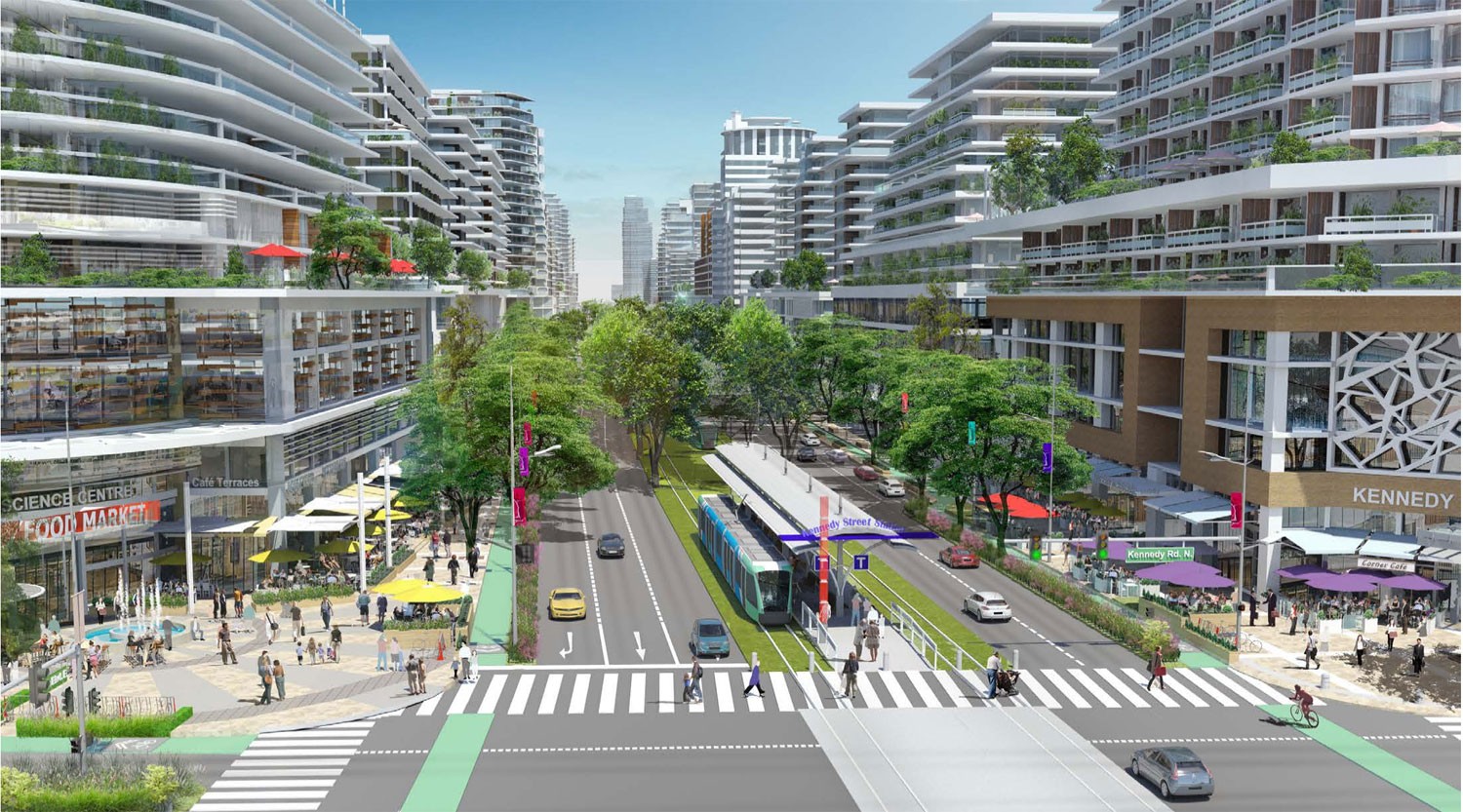
Will province miss the Brampton stop? Government provides few answers as LRT funding questions mount
Transit-minded. That's one way to describe more and more Brampton residents as increasingly clogged roads cost commuters valuable time every day. The incoming mayor has promised to find consensus on how to move the transit file forward, but a new roadblock created by Queen’s Park could quash the city’s vision for moving residents more efficiently.
The province will not say if it will put back on the table the roughly $300 million pledge the previous Liberal government retracted when council in 2015 voted down the provincially approved and fully funded Main Street LRT route.
Queen’s Park also is not saying whether it will get on board with any plan that a new council led by Patrick Brown might approve. The Mayor-elect has pledged to support the 2040 Vision, including its ambitious idea for higher order transit in the city, which the outgoing council adopted as the path forward for Brampton’s future growth.
Simmering for years as the population continues to boom, the transit issue spilled into the spotlight early during this term of council as the LRT debate created a collective consciousness that is now keenly focused on the city’s transit future. Now, with the municipal election in the books, and a new council with five new members set to be sworn in next month, many residents are feeling optimistic.
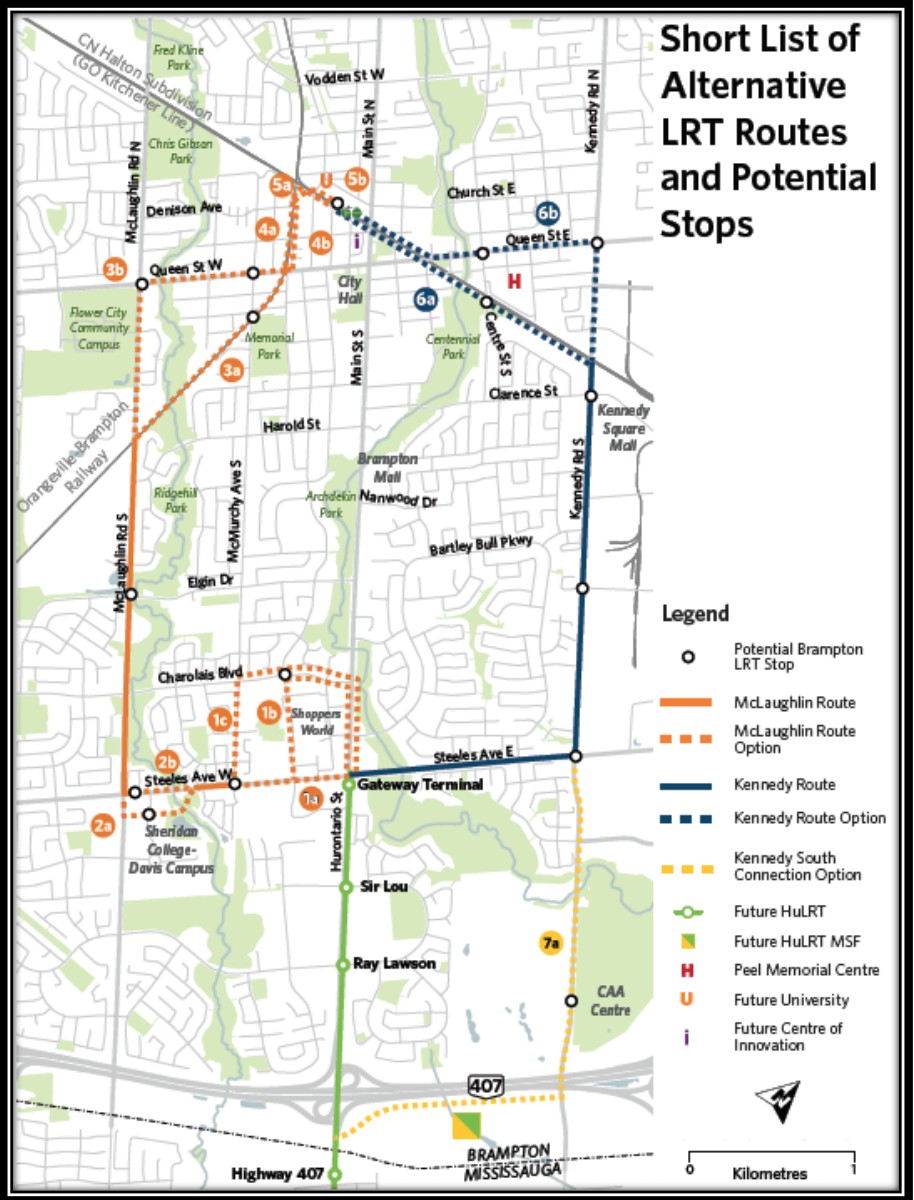
However, the city’s key transit decisions, some of which are laid out in the Brampton 2040 Vision document, are not going to be completed in a vacuum. Brampton will need the province of Ontario’s help to not only bring high-order transit into the core of the city, but to assist in creating hubs for transit across a region that is set to grow to over almost 2 million people by 2041, growth that will require development of regional express rail, high speed rail, and other future transit connections throughout the city.
The Pointer reached out to the Ministry of Transportation in response to a number of requests by the City of Brampton, put forward during the annual Association of Municipalities of Ontario (AMO) Conference earlier this year. The Pointer’s questions included inquiries about the city’s Brampton 2040 Vision, whether the province was aware of the plan, and where it fit with their long-range planning documents. The Pointer also asked about the fate of the funding set aside for the failed Main Street LRT route and whether further funding commitments for transit were coming Brampton’s way.
A spokesperson for Jeff Yurek, the minister of transportation, provided this brief response.
“Our government for the people is committed to improving the transit experience across the GTHA to get people moving and make life easier for Ontarians. We are determined to deliver a modern transit system that will serve the region’s growing communities, drive economic development and alleviate traffic congestion. Our decisions will be based on what is best for the people of the GTHA, including Brampton.”
The new chair of Metrolinx, the provincial agency that oversees transit planning across the Greater Toronto and Hamilton Area, the GTHA, has said he does not foresee any major cuts to Metrolinx’s ambitious plan for key regional transit projects. Don Wright, a former executive of TD Securities and the first person to lead the agency in a government not run by the Liberals, pledged in September, shortly after getting the job, that the PC government’s goal of dramatically reducing Ontario’s crippling deficit will not impact needed transit projects across the region. But no specific announcement about Brampton’s future priorities, and whether they could be in jeopardy, have been made.
Repeating the party line around transit, in lieu of real answers from the province, comes at a critical time for Brampton as more residents are starting to see the impact of poor transit planning on the city.
In response to a poll commissioned by The Pointer in late August, nearly a quarter of respondents noted that alleviating traffic congestion across the city needed to be the top priority for the incoming council. Over 60 percent of residents supported bringing LRT into Brampton (with a preferred route still undecided by many). When asked about the funding for such growth related challenges as improved transit, the largest proportion of respondents to The Pointer poll put the responsibility at the feet of elected officials inside Queen’s Park, with 29 percent blaming the province for underfunding growth across the city.
Brown is set to take the mayor’s chair at the start of December, bringing with him not only support for the city’s approved 2040 Vision plan, but also a tough Brampton-first stance that he repeatedly pledged while campaigning, one that could see him take a no-nonsense approach when dealing with the province on matters such as transit funding to support Queen’s Park’s mandated growth plan.

During his victory speech on Oct. 22, the elated Brown joyfully shared his vision to make Brampton the envy of the province.
He had strong words for any politician with plans to visit the city, something that is sure to become a common sight in 2019 as the country gears up for a federal election. Brampton is known as a hotspot for political campaigning from politicians of all stripes trying to win seats in higher levels of government.
“I want to say this very clearly: We’re not second-class citizens in Brampton,” Brown said during his speech. “As any leader visits Brampton, I want to have a very clear message: You want to visit Brampton, we deserve the investment that comes with that visit.”
Strong words, laced with hints of Hazel McCallion bravado (something Brown has referenced many times). McCallion was known for many things — results while negotiating with Queen’s Park and Ottawa were at the top of the list. For Brown, that will be the ultimate test, turning those words into much needed dollars Brampton requires to fund its explosive growth.
It’s a worrisome scenario for many who fear that Brown’s past, after being ousted by the PC Party, and his apparently rocky relationship with premier Doug Ford might be roadblocks to any future funding assistance for Brampton.
Potential hints of the animosity have already reared their head following Brown’s departure from provincial politics, including Ford axing the regional chair race after Brown put his name forward to run for the spot, and then pulling the approved $90 million in funding for a Ryerson university campus in downtown Brampton barely 24 hours after Brown was elected mayor.
For his part, Brown has continued to reiterate he is willing to work with all levels of government, regardless of who is in charge, in order to get what is best for Brampton.
A similar sentiment appeared in the brief statement from the province shared with The Pointer.
“Our decisions will be based on what is best for the people of the GTHA, including Brampton,” it read.
For Brampton in particular, the gap between current provincial assistance, and what the city believes is actually needed, is wide.
During discussions at the annual AMO conference, city staff delivered a presentation laying out a path toward what they believe is a better future for transit in Brampton, a “seamless integration of all transportation networks connecting Brampton with the the Greater Toronto and Hamilton Area and beyond,” the presentation reads.
In total, the city had five asks of the province, all of which have clear potential benefits to Brampton that won’t be realized if Queen’s Park continues to ignore the city’s growth-related pressures.
First, and many residents would not be surprised by this one, the city is looking for the province to hit the fast-forward button on the Hurontario LRT extension, seeking a partnership with Metrolinx to advance the LRT environmental assessment for connecting transit to downtown Brampton.
Currently, Brampton is working with Metrolinx to incorporate their ideas for bringing the LRT to the Brampton Gateway terminal, but after council voted down the Main Street LRT route into downtown Brampton, the provincial funding has evaporated, leaving the future of high-order transit into downtown uncertain.
The city has made it clear they have plans already in place, including the current ongoing study to determine the best route for the LRT into downtown. The study is costing Brampton $4.4 million and is basically a coin-toss between Kennedy Road and McLaughlin.
Making a decision on LRT is critical not only for the north-south transit routes in the city, but also for creating the ambitious double loop, which could be based on either an LRT or a Bus Rapid Transit system, envisioned in the Brampton 2040 Vision plan approved by council. The loop would connect Brampton’s future main cultural hubs of downtown and uptown with high-order transit, which could either be LRT, BRT or a combination of the two.
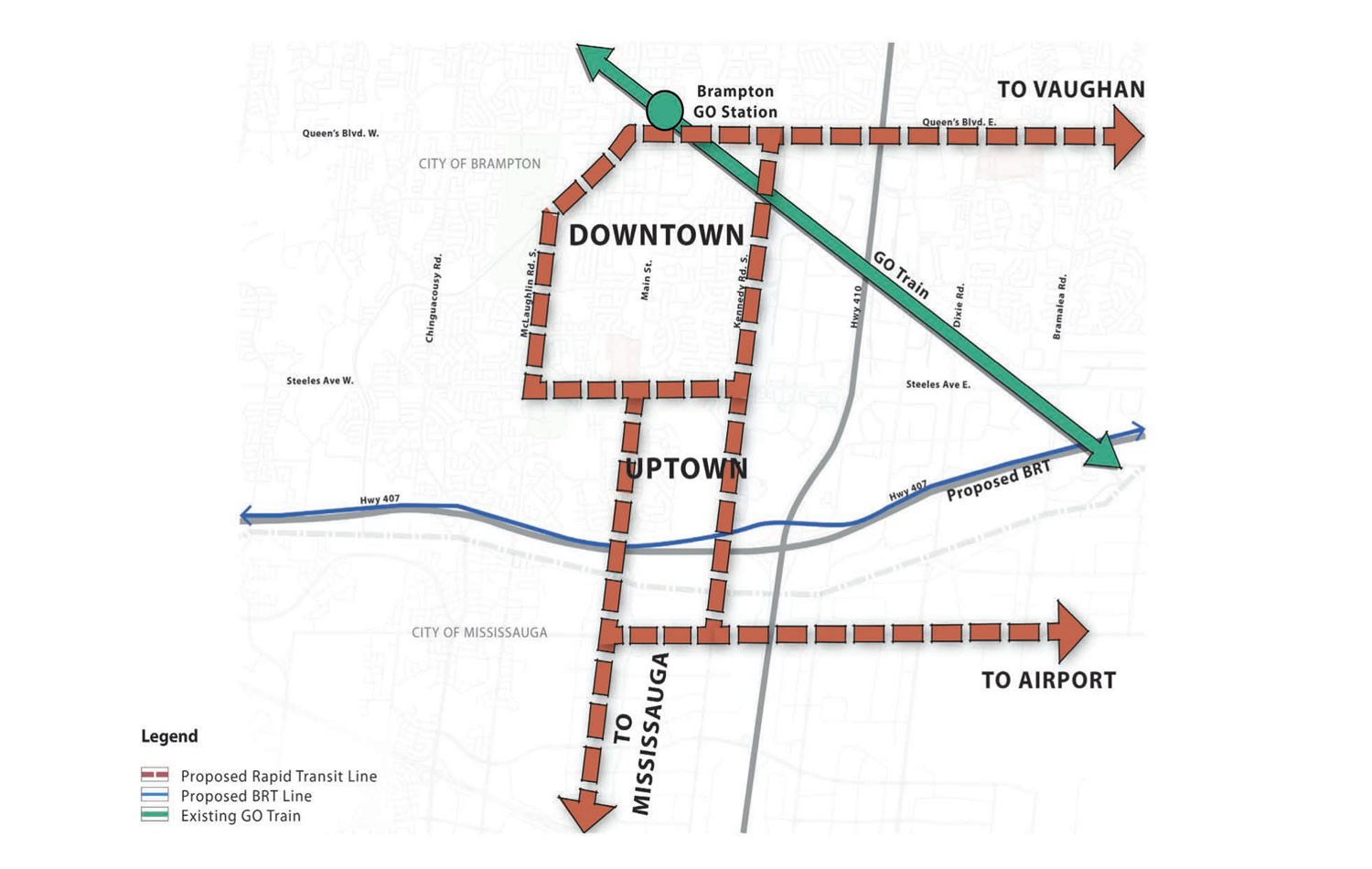
It’s unclear what kind of support Brampton could expect to receive from the province to fund this vision.
The city’s second ask of the province also has ties to the 2040 Vision. The city is looking to create a quartet of “mobility hubs” across the city, centred around the Brampton GO station, the Bramalea GO, the Hurontario-Steeles Gateway terminal and the Mount Pleasant GO station.
These hubs are set to become “places of connectivity where different types of transportation — like walking, biking and transit — come together and where there is an intensive concentration of working, living, shopping and/or playing,” the city states.
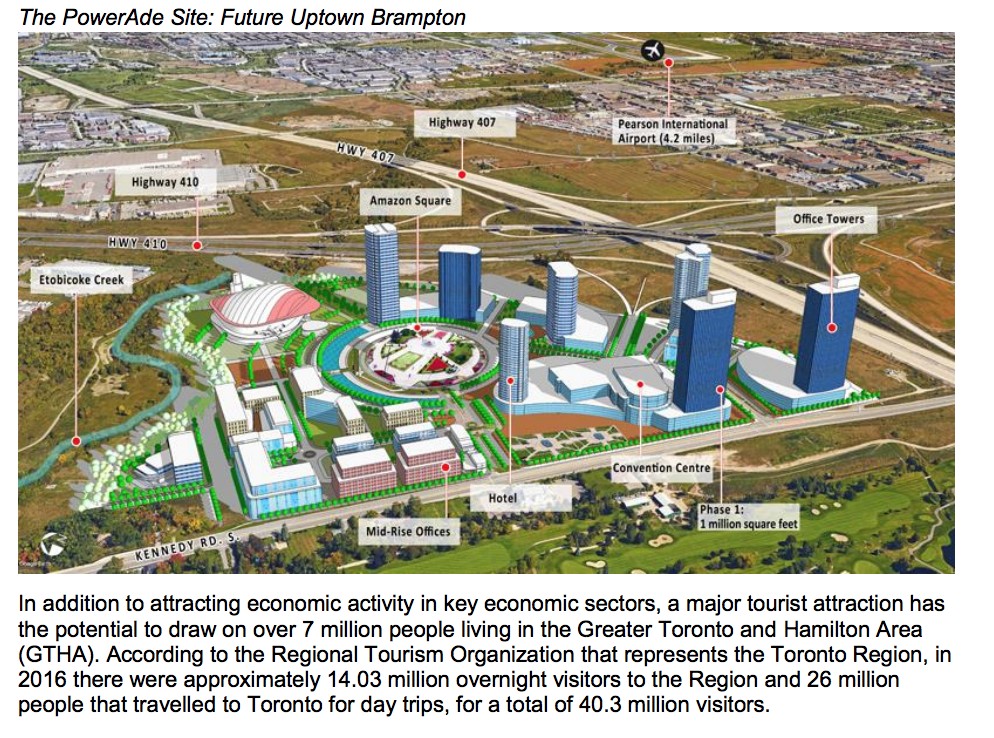
Brampton is looking to the province to help support the development of these hubs, with preliminary planning already underway for the Bramalea GO mobility hub, including an intensification corridor study as part of the city’s Official Plan review.
The final three asks all have a common goal of connecting Brampton to other portions of the GTA, or making it easier for commuters or travellers to move around and through the city’s main arteries.
First, city officials want to see the completion of GO regional express rail along the Kitchener GO line expedited ahead of the planned 2024 planned completion for 15-minute two-way all-day service between Bramalea and Union Station. It’s a plan that would help alleviate congestion issues along the corridor. Part of this plan would also include the freight bypass rail corridor to free up further capacity along the Kitchener GO line. At the same time, Brampton wants the MTO to consider a spot within the city for the future planned high speed rail corridor.
“The High Speed Rail corridor between Toronto and Windsor must provide a station in Brampton in order to connect to the other municipalities along Canada’s Innovation Super Corridor in support of economic growth and development in Brampton,” the city’s AMO ask states. Linda Jeffrey, despite touting the city as a future innovation hub along the corridor between Kitchener-Waterloo, failed to get the city a stop along the already proposed high-speed rail route. It’s unclear if the new PC government will move forward with the plan for the corridor that was created by the previous Liberal government.
The lands surrounding the Highway 407 corridor in Brampton are set to be a magnet for industry and an area that could provide much needed jobs for Brampton’s growing population of young and highly-skilled workers.
As part of its ask, the city wants the province to support connections between the 407/401 lands along Kennedy Road.
The property, previously put forward by the city as a potential location for Amazon’s HQ2, includes 112 acres of serviced/city-owned land that is ready for development. However, new ramps to the 407/410 highways are needed to support the future population. The city predicts that once built out, the area could attract up to 7 million people annually.
Finally, the city wants the province to put the development of the GTA West Corridor back on the table. The EA study for this 400-series highway corridor was suspended in 2015 and then cancelled in February of this year when the former Liberal government initiated the Northwest GTA Corridor Intensification Study.
While this study will look to protect lands in the northwest GTA for a transit corridor, the city is uncertain of the impact it would have (something they are working with the Region of Peel to figure out) on previous plans for a new major highway, which were stopped by the Liberal government.
On top of that, the lands previously part of the GTA West Corridor study, including swaths of employment land in north Brampton, are frozen until a final decision is made about what the province plans to do with the area.
“Without the GTA West Corridor, regional and local transportation infrastructure will be significantly strained in the future. This would impede the ability of Brampton to attract and retain employment affecting the City’s potential for economic growth,” the city’s document, which contains its complete list of requests to the province, states.
Solutions to Brampton’s transit woes could run like a cure through the veins of many residents hoping to see movement on issues such as jobs, investment and solving the crippling traffic that sit heavy in the hearts of Bramptonians.
Creating a better transit network would attract investment in business and industry that would provide a much needed boost to Brampton’s economy. For example, in Waterloo Region, following the approval of the Kitchener-Waterloo LRT, more than $2 billion of development occurred along the corridor between 2011 and 2015. In Brampton, projected economic impacts of the previously proposed LRT route sat at approximately $1.8 billion by 2031 due to the attractiveness of alternative modes of transit to GTHA developers.
In tandem, the business development would have the double-punch of knocking down Brampton’s sky-high tax rate by increasing the business tax-base and decreasing the burden on the backs of residential taxpayers.
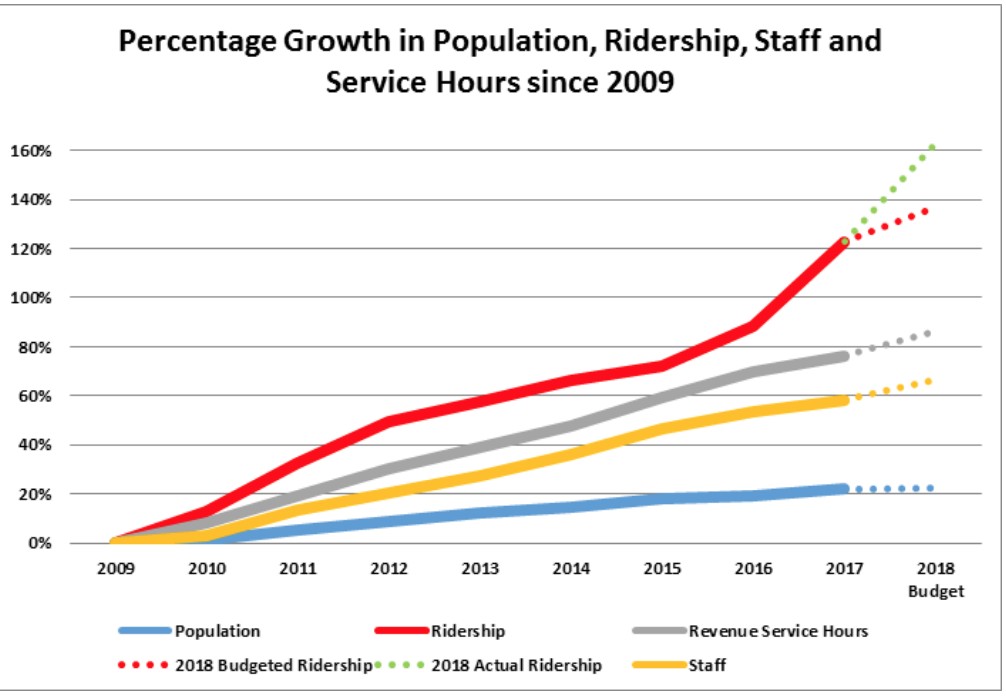
Healthier lifestyles, reduced greenhouse gas emissions, less stress on the road, more time with family, increased productivity, all of these are potential benefits of improving transit across Brampton. Many residents are already changing attitudes in the car-dominated city, which during previous decades was designed without thinking about the future. In 2017, annual transit ridership in the city increased to 27.4 million riders, an 18.4 percent increase over the year before.
But Brampton’s shift toward transit will be stifled if the province doesn’t get on board.
Submit a correction about this story


